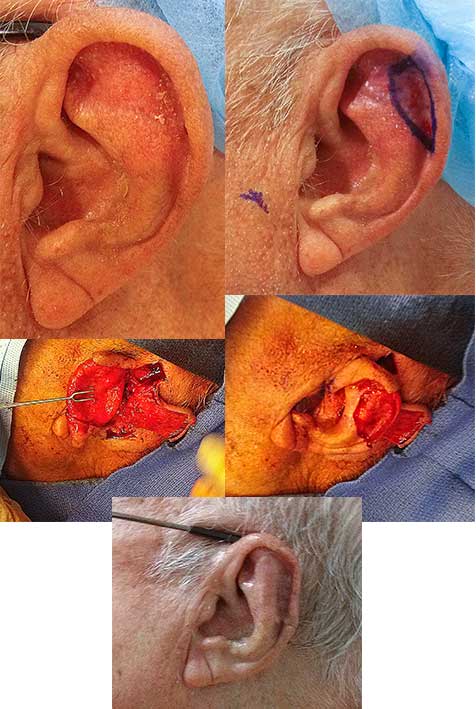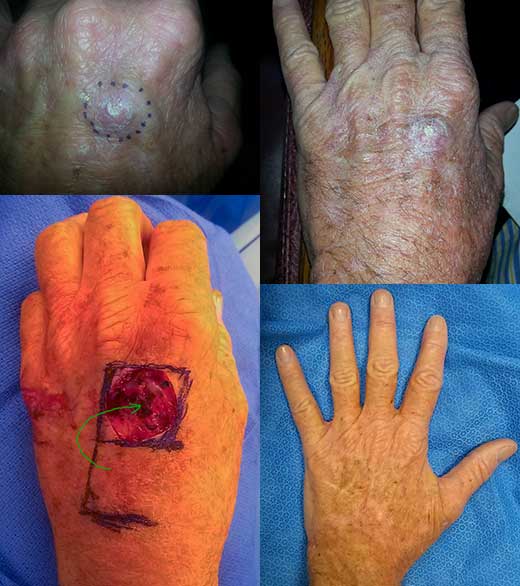- read about squamous cell carcinoma
- see before and after photos-videos
- alternatives, risks, benefits & recovery
Skin cancer is a condition of uncontrolled growth of cells in one or more layers of the skin. It is the most common form of cancer in the United States. They are so common that almost everyone will have some form of skin cancer sometime during the course of their life. The younger the age at which the first one is identified the greater the risk that you will have multiple skin cancers over the course of your life. The primary cause is prolonged and/or intermittent overexposure to ultraviolet radiation from the sun. Therefore most of these skin cancers appear on parts of the body unprotected from/exposed to the sun such as the face, ears or nose.
Factors that increase one’s risk for squamous cell cancer include sun exposure (it is frequently seen in surfers, outdoor construction workers…), light complexion, arsenic exposure, radiation therapy to the skin and immunosuppresive therapy after organ transplantation(especially heart and lungs). They begin as a small nodule and as it enlarges the center dies and sloughs so the nodule turns into an ulcer that may intermittently bleed. The tumor most frequently appears as a superficial surface lesion or a tumor below the level of surrounding skin that causes overgrowth of the overlying skin until it breaks through having a volcano like appearance.
It is important to treat squamous cell carcinoma as soon as their are diagnosed because unlike basal-cell carcinoma squamous-cell carcinoma (SCC) has a substantial risk of metastasis (spreading to distant parts of the body via local nerves or lymph nodes).

Squamous cell carcinoma of the ear marked for excision, removed and the resulting wound closed with a flap of skin from behind the ear.

Invasive squamous cell carcinoma of the hand marked for excision, removed and the resulting wound closed with a flap of skin from the back of the hand and a small skin graft from the thigh.
Video: Eyelid Basal Cell Carcinoma-Graft
Video: Eyelid Basal Cell Carcinoma-Flap
Read Dr. Stone’s blog about skin cancerSkin Cancer
Alternatives
The most common method employed by dermatologists to squamous cell carcinoma is currettage(scraping). The cancer is scraped until all the softer cancer tissue is removed. Other non surgical methods available are topical 5-FU cream or Imiquimod. Imiquimod has to be applied 5 times a week for 6 weeks and leaves the patient with a wound that looks worse than the cancer. It can take up to 12 weeks for the wound to heal. Imiquimod is more expensive than simple surgery and are only covered by health insurance in specific cases. Radiation therapy is also used but is mostly reserved for older patients who cannot tolerate surgery or have cancers in areas that cannot be excised.
Chemotherapy is only given to those with metastatic disease.
Risks
Proper care results in greater than 95% cure rates. Recurrent cancers are more aggressive & harder to cure. The recurrence rate is dependent on the entire removal of the cancer (proven by microscopic examination of the excised specimen). However, once you have had one you are obviously at greater risk of getting another anywhere you have skin than someone who has never had squamous cell carcinoma. They are only predictive of future basal cell carcinomas or squamous cell carcinomas of the skin. They are not predictors of any other type of cancer.
It is important that you wear strong sun screen anywhere you have had these skin cancers & all areas exposed to the sun.
As with any type of surgery there is the risk of infection or bleeding. If flaps are used to close the excision site there is a risk of partial or complete death of the skin in the flap. Closure of the excision sites can also result in temporary or permanent distortion of adjacent structures. If skin grafts are used they may have a different color and textures than the surrounding native skin.
Benefits
The benefits of early treatment are minimization of the potential for metastasis.
Recovery
The recovery is dependent on the surgery employed, if any. For skin graft closure there is generally 2 weeks of immobilization of the treated area. For flaps there may or may not be immobilization. Regardless of the surgery most patients are back to their usually life in 2 to 3 weeks especially if treated early.
Dr. Aaron Stone
Call today for a consultation!
9700 Venice BlvdCulver City, Los Angeles,CA 90232




